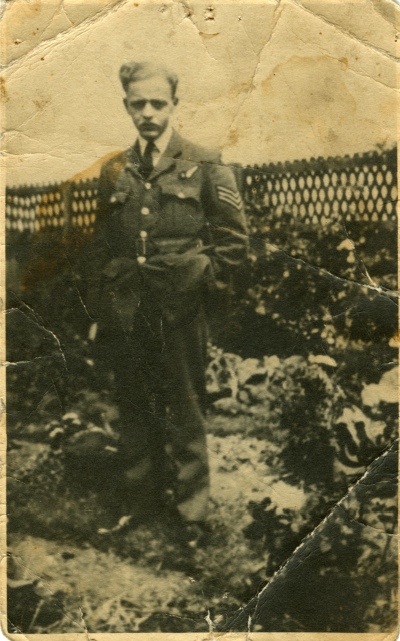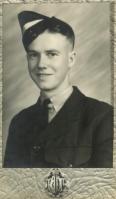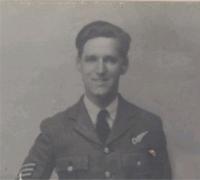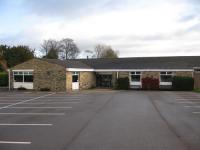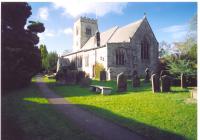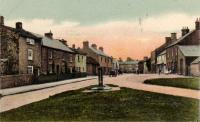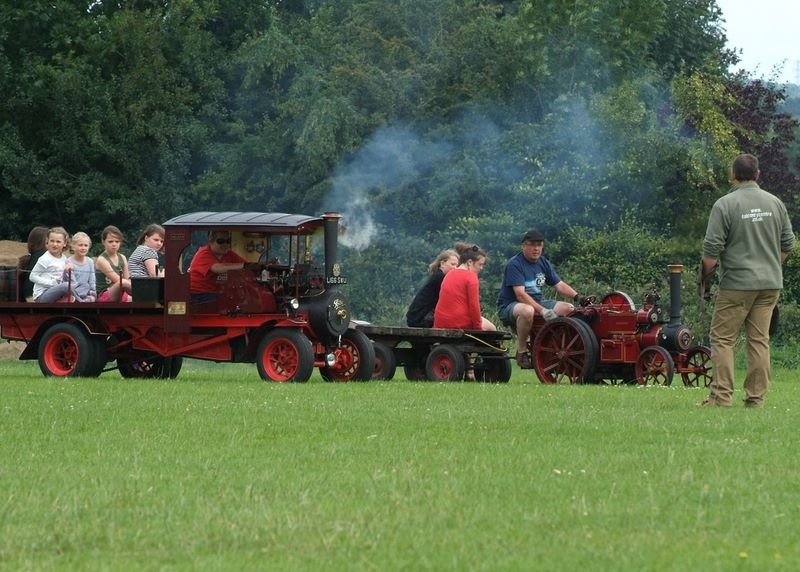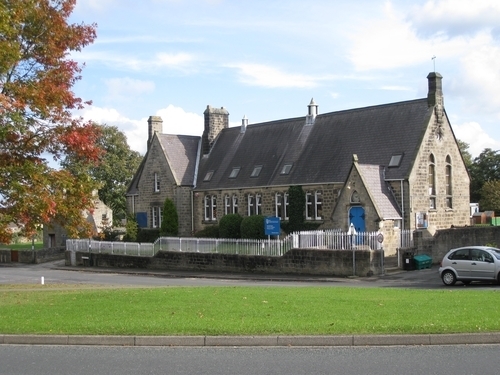-
Free genealogy websites will help you start your family history research at no cost as listed by the 'Who Do You Think You Are' magazine.
-
Memorial Hall kitchen is now completely, and expertly, refurbished by Neil,Batty Builders Ltd as a result of a grant awarded by the National Lottery's 'Reaching Communities' fund.See also the equivalent
-
A highly successful composer of the late Victorian and Edwardian eras, Amy Woodforde-Finden, together with her husband and step-son, is laid to rest in the churchyard of St Thomas à Becket Parish Church. Inside the church there is an impressive marble monument of her, created by the renowned sculptor George Edward Wade. It was unveiled in 1923 and a few years later, Finden Gardens in Hampsthwaite was named in her honour.[Click on title or image to link to articles]
-
Amy Woodforde-Finden : re-enactment of her memorial unveilingA wreath was laid on the white marble recumbent figure of Amy to mark the centenary of its unveiling in April 15th 1923.
Click on images to open full-size in new window and use the Browser back arrow to return to here.
-
Amy Woodforde-Finden : 'An Evening with Amy'A centenary concert to celebrate the life and works of Amy was held in Hampsthwaite Memorial Hall on April 21st 2023
Click on images to open full-size in new window and use the Browser back arrow to return to here.
-
Videos used throughout the site
-
Videos used throughout the site
-
Shaun Wilson's Collection of Newspaper Cuttings pertaining to Hampsthwaite Village:Index:Abattoir | Auctioneers | Boundary | Bowling | Bridge-River | Britain in Bloom | Brownies | Buildings | Chapel | Christmas Fair | Church | Dale Hall | Farming | Hampsthwaite Fashion Show | Feast-Show | Fundraising | General | Incidents | Joiners Arms | Fishing Club | Memorial Hall | Mile | Miscellaneous | Neighbourhood News | Parish Council | People | Play Group | Players | Play Scheme | Policing | Post Office | Reading Room | Residential | School | Sport | Surgery | Village Society | Wednesday Group | WI | Young Wives
-
PLEASE HELP - YOUR SUGGESTIONS ARE NEEDED URGENTLYWe are seeking ideas for how we might extend the facilities at the Memorial Hall. We are clear there is a need for better storage of some items and an enhancement of back-stage facilities to support our excellent Drama Productions.
-
Shaun Wilson's Collection of Newspaper Cuttings pertaining to Hampsthwaite Village:
© DT Online 2010 - 2024
| F Walton - biography
Frederick Walton
17th November 1924 – 10th August 1943Frederick, or Fred as he preferred to be known, was the youngest of seven children born on 17th November 1924 to Hardy and Sarah Jane Walton. Hardy was a skilled farm worker who worked with horses. Fred was over 20 years younger than his eldest brother Charles Arthur – my Grandfather. As the youngest child, he was much beloved by his brothers and sisters especially Evelyn who was closest to him in age. Every schoolday Fred and Evelyn would walk the two miles to school along Burley Bank Lane and down Rowden Lane from Heather House Farm where they spent much of their early childhood, moving to Skipton Road Farm in the mid ‘30s. Sometimes they would play in ‘Scurrah’s wood’, walk down the path in ‘Hell Hole’ and meet their Dad coming home from work. Fred had a penknife and carved his name on the railings of the bridge over the Cockhill Beck. The initials ‘FW’ were still there in the 1950s. Like all his brothers and sisters, he attended Hampsthwaite School. Most of the Walton children took and passed the exam to be allowed to go to the Grammar School in Harrogate but they were from a large family and they could not afford all the extra costs of going there so Fred stayed on at Hampsthwaite Elementary School till he left, probably around age 14. He had been an apprentice mechanic at Mackay's garage West Park, Harrogate, Yorkshire before the war. He was a bright capable lad but a terrible daredevil always getting into scrapes, he was remembered for “pulling wheelies” down the Skipton Road (A59) on his beloved motorbike. Coupling a sense of adventure with a mechanical interest, it was little wonder Fred was attracted to the glamour of the Air Force when war broke out. He was much influenced by his friend, Alan Chilton, who lived at Green Gables in Hollins Lane. Alan had already joined up and told exciting tales of his life in the RAF. Like a large number of young men, he volunteered to join the armed forces during World War II. Fred was too young to join the RAF; undaunted he lied to gain admission. He initially tried to join on 1st May 1941, but was rejected – probably for being too young! He was a determined young man; he again applied to the Number 2 recruiting centre at RAF Cardington (near Bristol) on 29th May 1941, just after his “18th birthday” - conveniently, citing his date of birth as being 17th May 1923. Hardy Walton, his Dad, was furious and tried to get him out but couldn't because he was a mechanic and the Air Force was short of them. It must have been a traumatic time for the family as Fred’s elder brother, John William, had died in suspicious circumstances in 1942. Fred was given the service number 1436208. A highly intelligent young man; he was to become a flight engineer, and sergeant aged just 19. Now accepted he was given the rank of Aircraftman second class.
Fred would have been ideal stature for his future role as a flight engineer, he was of slight build being 5’5” (for those preferring metric measurements that’s 1.65M) with a 31” chest (78.7cm) he can’t have weighed much more than 9 stone. He had blue eyes,light brown hair with a clear complexion. His small stature would have made it easier for him to manoeuvre in the confines of the aircraft, particularly around the engines and other moving parts.
In June Fred transferred to the recruiting centre in Skegness to continue his training. Then in July to RAF Hednesford (which is at Cannock Chase in the West Midlands), where he trained on the Pegasus engines.
Fred’s active service commenced with the 10th Squadron based at Leeming on 16th January 1942. The 10th Squadron flew Halifax bombers. He probably worked as a ground crew fitter whilst at Leeming.
Fred transferred to 1652 Conversion Unit (a unit flying Halifaxes) based at Marston Moor in March of ’42 eventually gaining promotion to Leading Aircraftman on 1st June 1942. It was here that Fred probably saw his first “active” service; however records at the conversion units are not as comprehensive as with squadrons. The principal role of the conversion units was to familiarise airmen with the aircraft used over enemy territory. 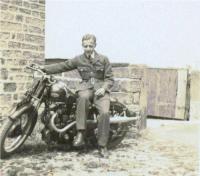
Following his promotion Fred transferred to RAF Cosford on the 28th July 1942 to attend a month long NCO training course. Fred passed the course with an exam result of 68.5%.
Following his NCO training he returned to 1652 conversion unit where he remained until 25th January 1943 when he moved to Number 10 (Observers) Advanced Flying Unit based at RAF Dumfries in Scotland, the unit flew Bothas, Ansons, Battles, Dominies and Henleys. The training was becoming more intense in preparation for front line duties as he went from Dumfries to 4th School of Technical Training based at RAF St Athan, Vale of Glamorgan, Wales. It was at St Athan where Fred took a flight Engineers course between the 19th March and 26th April. He passed the course gaining 72.6% (Grade “B”) gaining a promotion to the rank of Flight Sergeant. The photo of Fred was taken with his “Sergeants stripes” so must have been after passing the course.
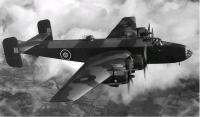 Handley Page Halifax Mk V
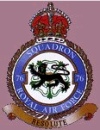 76th Squadron Badge
On the first of May he was moved to the 1663 Conversion Unit based at RAF Rufforth (Again flying Halifaxes). It was here he probably met and flew with an Australian called Colin McTaggart Shannon. Colin was the pilot of all the flights we have records of containing Fred. Colin McTaggart Shannon joined 1663 on the 27th April after completing his pilot training, just four days before Fred. The 76th Squadron was composed solely of Halifax bombers. They lost 204 aircraft during World War 2. Handley Page Halfax’s conducted over 75,000 bombing sorties, dropped 232300 Tonnes during World War 2 – more than a quarter of all bombs dropped by the RAF on Germany during World War 2. 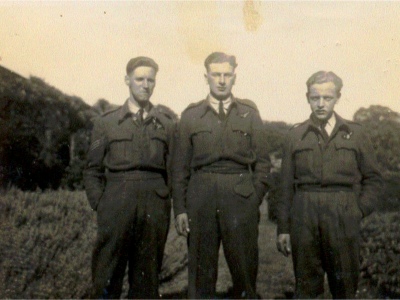 Torrance Buchan, Unknown, Fred Walton
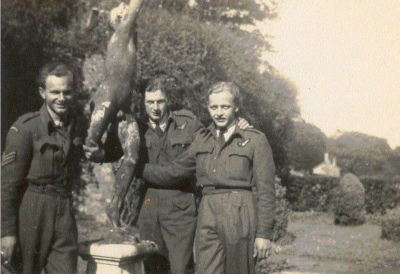 Fred Walton right with two unknown colleagues possibly fellow crew members
Holme-on-Spalding moor was typical of many wartime airfields it was cold and uncomfortable. Yet many who served there remembered it fondly, more for the comradeship than the squalid conditions. James Hampton in his book Selected for Aircrew described how much of the wooden furniture had been burnt on the stoves and asbestos had been fitted above the bunks to prevent further occurrences of arson. He wrote, “On no other RAF station, before or after, did I encounter such intolerable living conditions. Outside … there were muddy paths leading to the ablutions. The washing facilities were primitive and little interest was taken in trying to improve them or even maintain them properly.”
He remembered an almost complete lack of plugs and washbasins, something which was endemic in the wartime RAF and appeared to be accepted by a higher authority as a law of nature that could never be changed”. The conditions were in the main accepted with good humour. He continues: “Those that didn’t were usually advised by their fellows that if they couldn’t take a joke, they shouldn’t have joined!”
The squadron diary of the 76th Squadron confirmed that Fred was posted to Linton-on-Ouse on the 4th June 1942 moving to Holme-on-Spalding Moor on the 16th June 1943. The other aircraft members posted with Fred were F/O Shannon (Pilot), Sergeant Buchan (Air Bomber), Sergeant Shaw (Navigator), P/O Ellis (Wireless Operator / Air Gunner), Sergeant Smith (Air Gunner) and Sergeant Dodson (Air Gunner). The majority of the crew flew in the 11 missions before the fateful mission to Mannheim. Accounts from Colin McTaggarts family suggest the crew were not adverse to some high jinks. Colin was also from a farming family. They reputedly returned from one bombing run without deploying the bombs. On their return journey over Germany to Holme-on-Spalding Moor they spotted a herd of cattle, they thought it would be funny to obliterate the herd; needless to say their superiors didn’t see the funny side. There is a tantalising reference to bombs been ‘jettisoned’ on a mission to Wuppertal on the 24th June 1943, I have not seen any other reference to bombs been jettisoned by any other crew when searching records. Very few of the operations went without incident, it is very apparent that the crews of Bomber Command went through sheer Hell during their missions. The Halifaxes, in particular were noted for their difficulty in handling. Fred was in a terrible mental state by the time he was killed. He used to have terrible nightmares when he was at home. He used to say they got the crews drunk on rum in order to get them up in the air. This heavy drinking could, in part explain the boisterous high jinks for the attack on the herd of cattle (if indeed it did take place). Fred’s sister Nell used to wash Fred's clothes and knit him thick woolly jumpers and socks because it was so cold in the aircraft. He used to give her the washing on the milk round because he didn't always go straight home, going instead to his girlfriend, Sally Moore in New Park. We would love to know what became of Sally.
The most eventful missions were on attacks to Essen and the fateful sorties to Mannheim both are detailed below. A full list of sorties is included in the appendix at the end of the chapter. Essen; 25th July 1943The operation was only 24 hours after the eventful mission to Hamburg, when the aircraft (DK205) piloted by P/O Shannon made a crash landing on its return.
The evening of 25th July 1943 saw a major operation when Essen was attacked by 705 aircraft - 294 Lancasters, 221 Halifaxes, 104 Stirlings, 67 Wellingtons, 19 Mosquitos. The commander of the American VIII Bomber Command, Brigadier-General Fred Anderson, observed this raid as a passenger in an 83 Squadron Lancaster. Major damage was recorded in Essen's industrial areas in the eastern half of the city. The Krupps works suffered what was probably its most damaging raid of the war. The next morning, Doctor Gustav Krupp had a stroke from which he never recovered; this saved him from being charged with war crimes after the war. 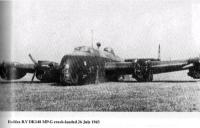 The Damaged Aircraft DK148, following the Emergency landing on its return from Essen
Fred was part of the crew of a Halifax DK148, the rest of the crew were F/L C M Shannon, Sergeant V S Shaw, Sergeant T Buchan, P/O W.C. Ellis, Sergeant E W Waterman, Sergeant Dodson. The aircraft suffered serious damage; reports vary from a dislodged airscrew that hit the fuselage to a shattered propeller on the port side with the engine catching fire. Control of the aircraft was difficult and the order to bale out was given. However after Sergeant Waterman did so, Colin McTaggart Shannon regained control of the aircraft. Unbelievably they proceeded to continue with the bombing run and were successful in their objectives. Sergeant Waterman was captured and spent time as a POW in Stalag Luft 4B, synonymous with “The Great Escape”. Despite the damage, the wireless operator, William Claude Ellis constructed a temporary aerial and guided the plane home where it landed at Holme on Spalding Moor at 04:26 on 26th July 2006. For the exploits of the flight both William Claude Ellis and Colin McTaggart Shannon were awarded the DFC (Distinguished Flying Cross); neither officer lived to receive the medal. The following is the citation in The London Gazette from the 17th August 1943
“Flight Lieutenant Colin McTaggart SHANNON (Aus 415055), Royal Australian Air Force, No. 76 Squadron. Pilot Officer William Claude ELLIS (132386), Royal Air Force Volunteer Reserve, No. 76 Squadron. One night in July, 1943, these officers were pilot and wireless operator/air gunner respectively of an aircraft detailed to attack Essen. When nearing the target, one of the port propellers was shattered and the engine caught fire. In spite of this, Flight Lieutenant Shannon went on to make a successful bombing run. The wireless apparatus was unserviceable as the aerials had been destroyed but Pilot Officer Ellis resourcefully erected an emergency aerial and thus was enabled to re-establish contact with base and obtain bearings which proved of material assistance to his pilot on the return flight. Both these officers displayed great skill and tenacity, setting an excellent example.” As Fred was the flight engineer it is inconceivable to think he didn’t play a significant role in the aircraft’s return to base. He would have controlled the remaining three engines, shut down the damaged engine and put right any damage that was necessary to limp the aircraft back to base.
On a visit home, probably leave given after the attack on Essen, a young 5 year old remembers been sat on his uncle’s knee. Fred promised that he would see him again soon. The enduring memory of that 5 year old was the shiny buttons of his uncle’s tunic. The 5 year old never did see his uncle again, and the vision was still as clear as the day it happened over 60 years later. That 5 year old is Jim Walton my father. 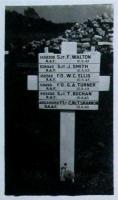 Grave Marker for the Crew of LK892 (ca 1946)
Mannheim; 9th August 1943457 aircraft - 286 Lancaster’s and 171 Halifaxes were involved in the raid on Mannheim. The target area was mainly cloud-covered and the Pathfinder plan did not work well. 9 aircraft, 6 Halifaxes and 3 Lancasters were lost in the raid, one of which was LK892. The Crew were in Halifax LK892 “C” were returning home after the mission to Mannheim. They were “picked up” in spotlights, and shot down at 03.49 hours on the morning of Tuesday 10th August 1943. The plane crashed on a rail track at Aubengue, Pont du Garannes in the area of Wimeraux 5 miles due North of Bologne (Close to the current Channel Tunnel terminal at Calais). It burned furiously for several hours. The crew were burned beyond recognition, with the exception of the rear gunner, John Dodson, who died of a fractured skull. Rear gunners were affectionately referred to as “Tail end Charlies”. As he was at the rear of the aircraft he was least likely to have suffered burns. 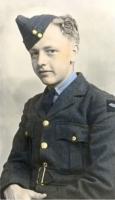 Frederick Walton 1924 - 1943
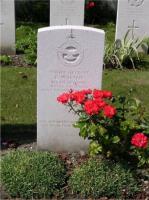 Frederick Waltons Grave 2004
All the airmen were buried by the Germans in separate graves. Torrance Buchan, John Dodson and Frederick Walton were all allocated there own marked grave, it was assumed they had found identifying evidence for both Torrance and Fred.
Following an investigation after the war (conducted on 22nd November 1946) all the bodies were exhumed. Very few remains were found of Colin McTaggart Shannon, Geoffrey Austin, Torrance Buchan, William Claude Ellis, John Smith or Frederick, certainly nothing to give a positive identification. They did, however, find one set of stripes belonging to a sergeant, but there were four sergeants on board the aircraft. The decision was taken to bury the colleagues in a communal grave. John Dodson retained his individual grave. The marker for the communal grave as erected in the 1940s can be seen above. The mother of Colin McTaggart Shannon visited the scene after the war, travelling from a remote farming area in Western Australia. She met the farmer whose land the plane came down on. He said he tried to help the crew but was beaten back by the flames. Colin’s mother was in contact with Bill Ellis’s family for some time after the war. Our Grandmother, Sarah Jane Walton, also wrote to the families but the letters are lost. Colin’s brother had just joined him at the airbase, as the crew were to start a period of leave. They had been persuaded to do one final mission. After the death of the crew a girl from London wrote to his mother – Colin had just become engaged. According to family legend, Fred's apparition appeared to his sister Nell the morning after his death while she was feeding the cows in the front mistal, saying he was all right! At this stage she didn’t know he was already dead. Something remarkable happened on All Souls’ Day in 2002. Evelyn Herron (nee Walton, Fred's sister) received a letter from a woman from Silverdale, Lancashire, enclosing a photo of Fred. On the back of it was written in pencil "if found please return to Mrs Walton, Dairy farm, Skipton Road, Hampsthwaite" Evelyn wrote to her and it emerged that her son had picked up the photo among the flowerpots in a garden centre and had brought it home. She had posted it off thinking it might be very precious to someone. We wondered if it had been carried around by Sally or some other girl or friend and lost. 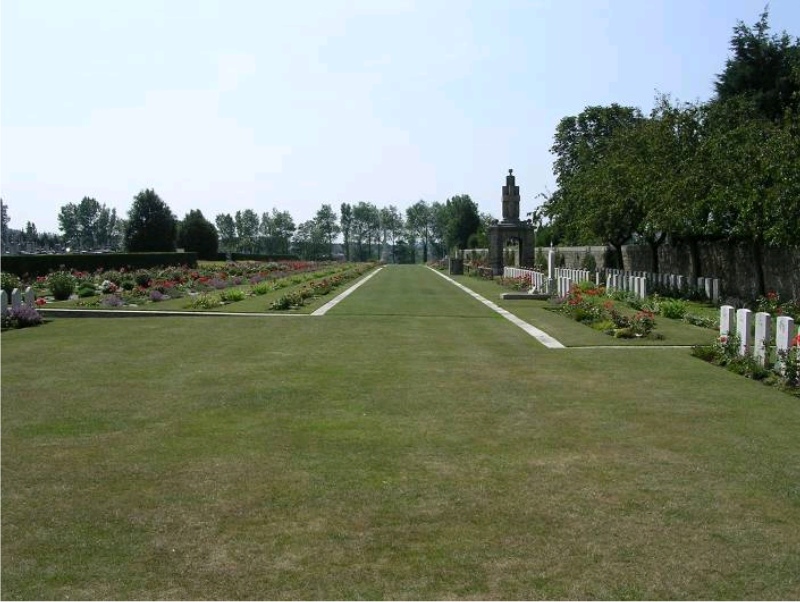 Bologne Eastern Cemetery - Final resting place of the Crew of LK892
The rest of the crew of LK892 were as follows:
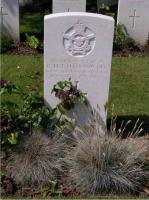 Colin McTaggart Shannon (age 25)
415055 Flight Lieutenant Colin McTaggart Shannon DFC RAAF (age 25)Colin was born on the 13th April 1918 to Pultney Malcolm Murray Shannon and Eva Johnson Shannon, of Narrogin East, Western Australia.
415055 Flight Lieutenant Colin McTaggart Shannon DFC RAAF (age 25) 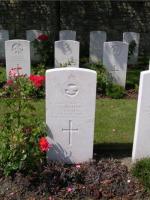 Torrance Buchan (age 28)
655439 Sergeant (Air Bomber) Torrance Buchan (age 28)Torrance was a son of Torrance and Mary Buchan and the husband of Elizabeth Buchan, of Peebles. (Near Edinburgh). 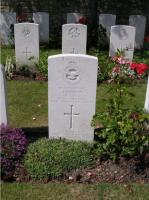 John Dodson (age 21)
1129601 Sergeant (Air Gunner.) John Dodson (age 21)John was a son of William Henry and Agnes Dodson, of Huddersfield. 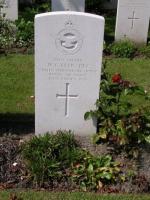 William Claude Ellis (age unknown)
132386 Pilot Officer (Wireless Operator./Air Gunner.) William Claude Ellis DFC (age unknown)(There are no details of Williams’s next of kin). 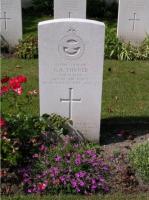 Geoffrey Austin Turner (age 23)
113498 Flying Officer (Navigator.) Geoffrey Austin Turner (age 23)Geoffrey was a son of Austin Victor Turner, and of Dorothea Margaret Turner, of Glasgow. 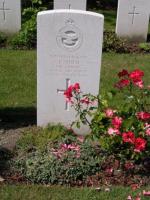 John Smith (age unknown)
928040 Sergeant (Air Gunner.) John Smith (age unknown)John was a son of Robert John and Florence Louise Smith of Norwich. His brother Walter Charles also died on service. AppendixDetails of the sorties flown by the crew are as follows: | Date | Operation | Aircraft | Crew | Details | | 11th June 1943 | Dusseldorf | DK166 “D” |
P/O C M Shannon
Sgt T Buchan
Sgt V S Shaw
P/O W C Ellis
Sgt L G-Price
Sgt F Walton
Sgt J Dodson
|
Flight time
From: 22.14
Return: 01.15
Returned early due to setting course late having been lost on circuit and thus late by 12 minutes at Southwald. Furthest point reached on track 52 07’N/02 23’E
| Weather: Cloudy. Intermittent rain & showers. The eighteen aircraft which were detailed for last nights attack on Dusseldorf took off in good time. The take off was witnessed by some high ranking officers of our Russian allies and they were high in there praise at the efficiency with which the aircraft were speedily airborne. Weather conditions were not favourable and four aircraft were obliged to make an early return to base. The remaining fourteen however reached and bombed the target. This was a very successful raid and explosions were witnesses (sic) around the aiming point. Many large fires added to the confusion. Two of our crew failed to return and were reported missing. The total operational flying time was 86.35 hours. | | Date | Operation | Aircraft | Crew | Details | | 12th June 1943 | Bochum | DK168 “G” | P/O C M Shannon
Sgt T Buchan
Sgt V S Shaw
P/O W C Ellis
Sgt L G-Price
Sgt F Walton
Sgt J Dodson
| Flight time
From: 22.48
Return: 05.10
Target identified by red and green markers and bombs released on one ground marker at 01.17 hours from 18,000 ft. Own results not observed. | Weather: Cloudy, with fair periods, becoming fine in the evening. Fresh W'ly wind, afternoon and evening. During the night Bochum received yet another heavy blow from a large force of heavy bombers. The attack was carried out in very clear visibility and explosions and large fires were seen. One aircraft (F/S Pulla, Captain) failed to return from this raid. | | Date | Operation | Aircraft | Crew | Details | | 21st June 1943 | Krefeld | DK205 “C” |
P/O C M Shannon
Sgt T Buchan
Sgt V S Shaw
P/O W C Ellis
Sgt J Smith
Sgt F Walton
Sgt J Dodson
| Flight time
From: 23.59
Return: 04.51
(First aircraft airborne from the squadron).
Attacked primary target at 02.18 hours from 19,000 feet. Identified by red and green markers. Markers in bomb sight. The whole town was well alight. A very successful attack. | Weather: Some showers in the morning, then fair to fine with good visibility. Of the twenty aircraft that took off to attack Krefeld sixteen succeeded in reaching the target. The other four returned early due to technical faults in the aircraft. Last night's raid, has been described by bomber command as one of the most successful of the war, and the recommaignance (sic) have brought back proof that the gas works, electric power station and water works have been completely destroyed. | | Date | Operation | Aircraft | Crew | Details | | 23rd June 1943 | Mulheim | Aircraft “C” (P/O Shannon, Captain) was cancelled owing to his navigator reporting sick (Sergeant Shaw)
| | Date | Operation | Aircraft | Crew | Details | | 24th June 1943 | Wuppertal | DK205 “C” | P/O C M Shannon
Sgt T Buchan
Sgt V S Shaw
P/O W C Ellis
Sgt J Smith
Sgt F Walton
Sgt J Dodson
| Flight time
From: 22.51
Return: 01.30
Operation abandoned owing to Port Engine going u/s. Furthest point reached 20 miles 120o Thetford. Bombs jettisoned. | Weather: Fair with good visibility.
Of the twenty aircraft which took off during the night to attack Wuppertal; two aircraft returned were compelled to return due to engine faults.
N.B. One was DK205 when the bombs were jettisoned, maybe when the herd of cattle was targeted! | | Date | Operation | Aircraft | Crew | Details | | 25th June 1943 | Gelsenkirchen | DK201 “P” | P/O C M Shannon
Sgt T Buchan
Sgt V S Shaw
P/O W C Ellis
Sgt J Smith
Sgt F Walton
Sgt J Dodson
| Flight time
From: 23.19
Return: 04.15
Attacked primary target at 01.21 hours from 19,000 feet. Identified by PFF markers. GEE u/s a bit off track. | Weather: Mainly cloudy, with much cloud at 2 yo 3,000 feet. Good visibility. Last night our aircraft attacked Gelsenkirchen in great strength. The raid was carried out in 10/10th cloud. This city is a very important target and has large marshalling yards capable of handling 4,000 waggons (sic) daily. Around the target are large steel works and two very synthetic rubber oil plants. | | Date | Operation | Aircraft | Crew | Details | | 9th July 1943 | Gelsenkirchen | DK205 “C” | P/O C M Shannon
Sgt T Buchan
Sgt V S Shaw
P/O W C Ellis
Sgt J Smith
Sgt F Walton
Sgt J Dodson
| Flight time
From: 22.53
Return: 05.52
Attacked primary at 01.28 hours from 20,000 feet. Bombed on ETA unable to see markers. | Weather: Cloudy with occasional rain or drizzle. Of the twenty aircraft to attack Gelsenkirchen last night, nineteen succeeded in reaching and bombing the target area. Aircraft “A” (F/S. Myers, Captain) was forced to turn back early due to the hydraulic system becoming unserviceable. The attack was carried out by a large force of heavy bombers,, this been the second attack in a few days. Unfortunately results could not be assessed owing to 10/10th. Cloud which prevailed, but at the height of the attack a large explosion, followed by the glow of fires penetrating the cloud, was seen. Aircraft “U” (Sgt. Hewson, Captain) sustained damage over the target, but the aircraft was brought back safely to base. A successful crash landing was effected. Sgt. Isaacs and the air bomber sustained injuries to the back. | | Date | Operation | Aircraft | Crew | Details | | 15th July 1943 | Mt Bilard (sic) (Mount Beliard) | DK205 “C” | P/O C M Shannon
Sgt T Buchan
Sgt V S Shaw
P/O W C Ellis
Sgt J Smith
Sgt F Walton
Sgt J Dodson
| Flight time
From: 21.44
Return: 05.57
Target identified by PFF markers and bombed one red ground marker at 01.55 from 8,000 feet. Own bombs were seen to explode under the red markers which was dying out. | Weather: Cloudy with rain in the morning and afternoon. Strong winds. Fine in the evening. A record number of aircraft for this squadron, took off to attack Mont Beliard. The aiming point was a large and important factory which manufactures tanks and transport vehicles for the enemy. The twenty three aircraft, led by Wing Commander Smith in “S” carried a comparatively low level attack on the factory and bombs were seen to straddle the works. Large explosions and fierce fires were observed in and around the aiming point. Visibility was perfect and there was no difficulty experienced in identifying the target. All our aircraft returned safely to this country, but “S” owing to a shortage of petrol; made a perfect “belly landing” just outside Goole, after four members of the crew had baled out. The total flying time for his operation amounted to 185.30 hours. | | Date | Operation | Aircraft | Crew | Details | | 24th July 1943 | Hamburg | DK205 “C” | P/O C M Shannon
P/O Dumphy
Sgt T Buchan
Sgt V S Shaw
P/O W C Ellis
Sgt J Smith
Sgt F Walton
Sgt J Dodson
| Flight time
From: 23.04
Return: 02.31
(First aircraft airborne from the squadron). Operation abandoned. Furthest point reached 54 37’N/06 03’E. Port inner engine unserviceable. Thick black (smoke) emitting from exhaust and oil pressure down. | Weather: Fine All the aircraft detailed to attack Hamburg took off and were quickly airborne. This port was successfully identified and bombed by our crews who report many explosions and concentrated fires in the T/A. It is regretted however, that aircraft “M”(F/O. Such, Captain) failed to return and has since been reported missing. In losing this crew the squadron suffered a great loss. F/L Shannon in aircraft “C” made a crash landing at base due to engine failure, but fortunately without any member of the crew sustaining serious injury. Three other aircraft also made early returns due to technical failures. The total operational flying was 124.50 hours. | | Date | Operation | Aircraft | Crew | Details | | 25th July 1943 | Essen(2) | DK148 “G” | P/O C M Shannon
Sgt T Buchan
Sgt V S Shaw
P/O W C Ellis
Sgt E W Waterman(3)
Sgt F Walton
Sgt J Dodson
| Flight time
From: 22.16
Return: 04.26
Attacked primary at 01.02 hours from 17,000 feet. Identified by PFF flares. One green TI in bomb sight when bombing. Whole target covered by fire and smoke. | Weather: Fine, Ground fog at dawn. Twenty of the twenty two aircraft detailed to attack Essen during the night reached the target area, and the crews on their return reported a very successful and concentrated attack on the target. Aircraft “K” (F/S Whittle, Captain) returned early due to one of his engines overheating and aircraft “Q” (Sgt. Ward, Captain) returned with his Port and Starboard engines unserviceable. Over the target area aircraft “G-” (F/L Shannon, Captain) lost one of his propellers, which came off and hit the fuselage. An order was given to bale-out, which was later countermanded, but in the meantime one of the Gunners, Sgt. Waterman, had left the aircraft. F/L Shannon was successful in reaching Base and carried out a belly landing. From this operation all our aircraft returned safely. The total flying hours were 102.50 hours. | | Date | Operation | Aircraft | Crew | Details | | 2nd August 1943 | Hamburg | DK204 “H” | P/O C M Shannon
Sgt T Buchan
Sgt A C Samuel(4)
P/O W C Ellis
Sgt J Smith
Sgt F Walton
Sgt J Dodson
| Flight time
From: 23.36
Return: 05.46
Attacked what was believed to have been Wilhelmsburg at 02.29 hours from 15,000 feet. No markers were seen and bombs were released on ETA. Some fires seen in what was believed to be the Hamburg area. Electrical storms and severe icing encountered. | Weather: Cloudy, showers in late afternoon and early evening, Visibility good most of the day. Moderate in latter part of night. Last night 20 aircraft from the squadron took-off to attack Hamburg. 2 aircraft, after about 2 hours flying returned on three engines. Very stormy weather conditions were encountered by the others and over the target, visibility was very poor. Our aircraft bombed on ETA but results were not observed. 1 aircraft failed to return. | | Date | Operation | Aircraft | Crew | Details | | 9th August 1943 | Mannheim (5) | LK892 “C” | P/O C M Shannon
Sgt T Buchan
Sgt G A Turner
P/O W C Ellis
Sgt J Smith
Sgt F Walton
Sgt J Dodson
| Flight time
From: 22.50
Failed to Return
This aircraft took off at 22.50 hours from Holme-on-Spalding moor, since when nothing has been heard. It is therefore reported missing. | Weather: Fair becoming cloudy, with slight rain in the evening. During the night 16 aircraft took off to Mannheim and it is known 14 succeeded in reaching the target area, which was successfully identified and attacked. F/L Shannon and crew failed to return and have since been reported missing. Aircraft “F” (Sgt Ward Captain) returned early due to being unable to gain sufficient altitude. The only other flying by “V” Victor (Sqn/Ldr Stuart, Captain) who landed away from base, on return from last nights operations. |
Details and notes as per 76 squadron ops and diary.
- Leonard John Glover-Price was posted missing on 28th June 1943 on operations to Cologne (Köln) in DK150 piloted by D Coles; he is buried in Reich Wald Forest War Cemetery
- Please see separate section for a more detailed account on the operation to Essen.
- Sergeant E W Waterman; replaced Sergeant J Smith as air gunner for this operation, he was held prisoner of war at Stalag Luft 4B.
- Sergeant Alec Cecil Samuel; replaced Sergeant Shaw as the navigator (Sergeant Shaw never flew with the crew again, was he injured in the operation to Essen?) Sergeant Samuel died on 12th August 1943 aged 22 in operation to Milan (DK240 piloted by P/O B S McCann a veteran of 20 Sorties), he is buried in Bernay.
- Please see separate section for a more detailed account on the fateful operation to Mannheim.
- DK201 was lost on operations to Kassel on 3rd October 1943
- DK166 was lost on operations to Wuppertal on 24th June 1943
- Walter Charles Smith, 810792. Royal Corps of Signals attd. 12th Indian Inf. Bde. Sig. Sec. Indian Signal Corps. 9th September 1945. Age 32.
Nomenclatureu/s – Unserviceable
PFF – Pathfinder Force
ETA – Estimated time of arrival
GEE – Navigational aid (early form of radar)
TI – Target Indicator Sources1. Commonwealth War Graves Commission
2. Frederick Walton personnel records
3. Colin McTaggart Shannon personnel records
4. 76 Squadron Ops / ORB and Squadron Diaries
5. Edith Walton (Fredericks Sister)
6. Angela Sansam
7. “To See the Day Dawning” W Chorley
8. “Yorkshire Airfields in the Second World War” Patrick Otter
9. Allan Taylor
10. http://www.worldwar2exraf.co.uk
11. Jim Walton
12. LK892 Accident report
13. www.lostbombers.co.uk.
14. www.rafcommands.com
15. www.network54.com
"This detailed and interesting account was prepared by Frederick's great nephew Nick Walton and we are indebted to him for permission to use it here".
F Walton - biography Frederick Walton
17th November 1924 – 10th August 1943
|
